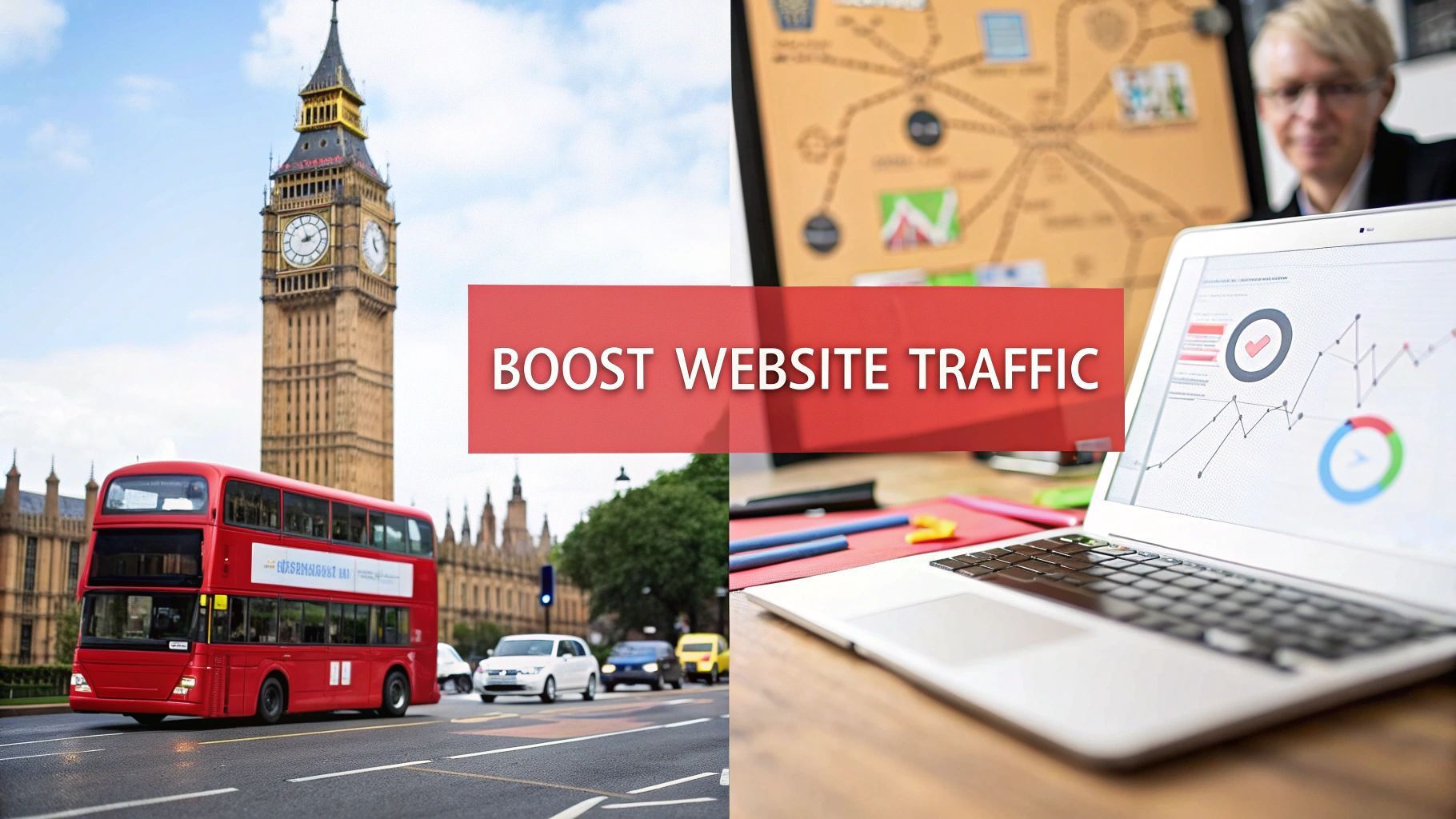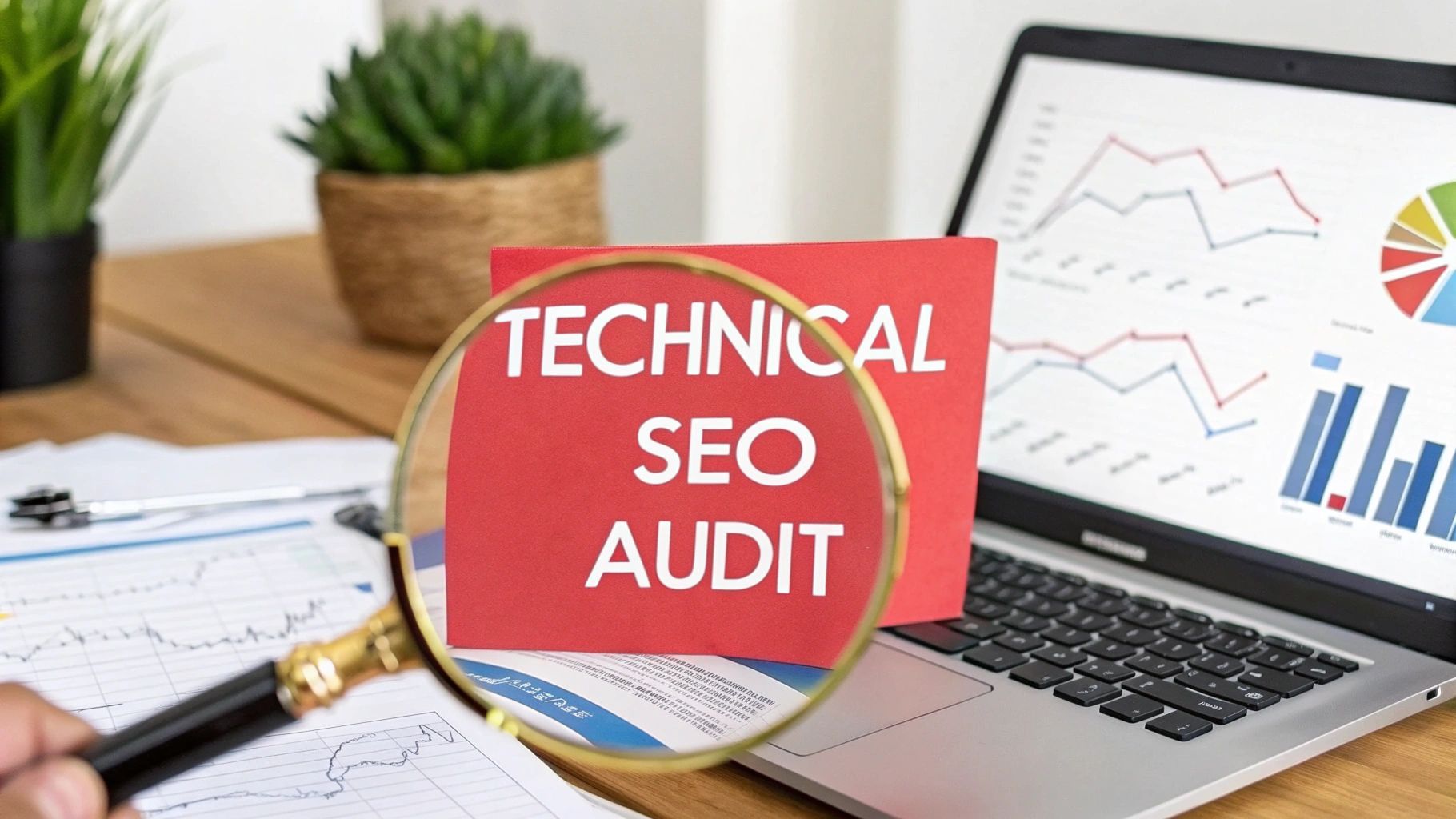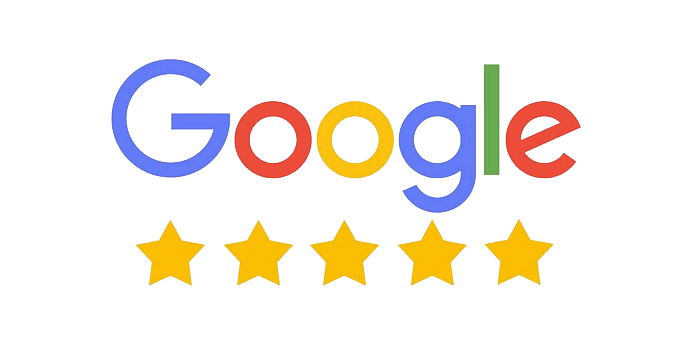How to Increase Brand Awareness That Lasts
Getting your brand noticed is about more than just shouting into the void. It’s a thoughtful process that starts with knowing who you are and then consistently showing up everywhere your audience is. The goal is to weave your brand's story into every interaction, building familiarity and, eventually, trust.
Building a Foundation for Lasting Brand Recognition
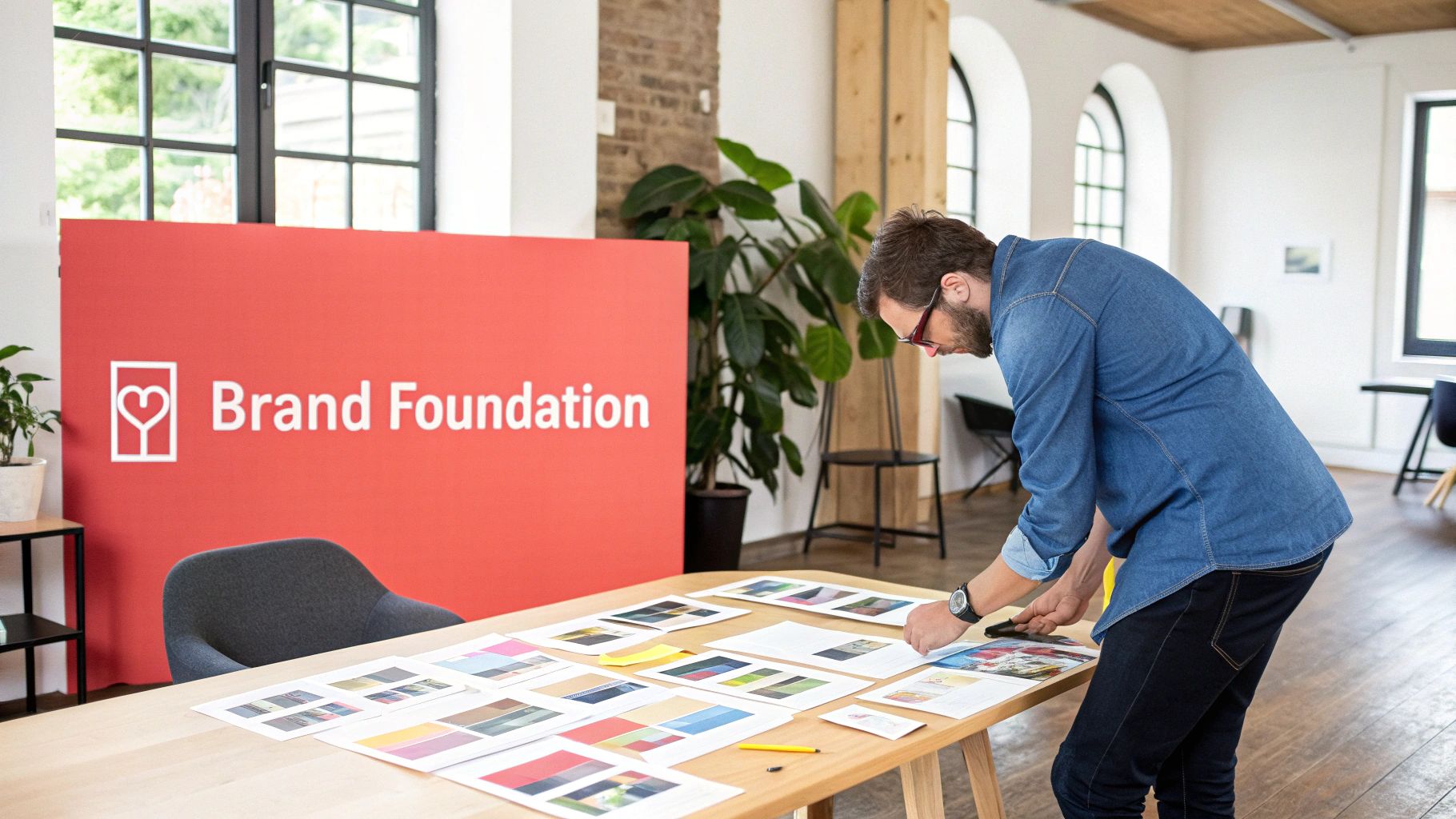
Before you can build awareness, you need a brand people want to recognise. This goes way beyond a flashy logo; it's about the feeling you leave people with and the trust you inspire. It’s a common misstep to dive headfirst into marketing without first getting crystal clear on what the brand actually stands for.
This foundational stage is where you get specific about your ideal customer and build a story that resonates. A compelling narrative connects with people on a human level, making you memorable for reasons that have nothing to do with price. If you want to dig deeper, we have a detailed guide on how brand storytelling builds loyalty and revenue.
Define Your Brand Identity
Think of your brand identity as your business’s personality—it's the promise you make to your customers and the very thing that makes you different from everyone else in your space.
To get to the heart of it, you need to answer some big questions:
- What's your mission? Beyond the balance sheet, why does your business exist?
- What are your values? What are the non-negotiable principles that guide every decision?
- What's your brand voice? Are you the straight-talking expert, or the witty, approachable friend?
The answers will become the blueprint for every single piece of content you produce, from your homepage copy to your social media replies. For anyone just starting out, this guide on how to build brand awareness from scratch is a great resource for nailing these early steps.
Establish Consistency Everywhere
Consistency is the absolute bedrock of brand recognition. When your brand feels disjointed, it creates confusion and erodes trust before you’ve even had a chance to build it. It's vital to maintain a cohesive look, feel, and tone across every single touchpoint.
Your brand is what other people say about you when you're not in the room. A consistent identity ensures they are all telling the same story, reinforcing the image you want to project.
This means your logo, colours, and fonts should be identical on your website, your business cards, and your LinkedIn profile. The way you write an email needs to sound like the person who wrote your blog posts. It’s this seamless experience that builds a strong, instantly recognisable presence.
This isn't just about looking good; it's about building trust. Research confirms that 81% of consumers need to trust a brand before they even consider buying, and 88% point to authenticity as a major factor in who they support. And since 55% of first impressions are purely visual, those consistent design elements are doing some serious heavy lifting.
Using Digital Content to Amplify Your Voice
A solid brand foundation is one thing, but it’s the content you create that actually gives your brand a voice online. In a world where your customers are constantly searching for answers, creating genuinely valuable content is your best bet for getting noticed. It’s all about switching from a "sell, sell, sell" mindset to one of being genuinely helpful.
Forget just shouting about product features. Your real goal is to become the go-to resource in your niche. Think about it: insightful articles, practical video tutorials, and shareable infographics that hit on the exact pain points and questions your ideal customers have. This isn't just about attracting an audience; it’s about positioning yourself as the expert they trust.
Harnessing the Power of Content Marketing
Content marketing is the engine that drives modern brand awareness. It’s a long game, for sure, but it’s one focused on building real relationships with your audience by consistently giving them quality, relevant information. When you get it right, it pulls people towards your brand naturally, without the hard sell.
So, what does effective content marketing actually look like?
- Provide genuine value: Your content has to solve a problem, answer a question, or at least be entertaining. For example, a catering company could share a guide on "Planning the Perfect Garden Party," offering real tips that people can actually use.
- Be consistent: A regular publishing schedule, whether it's a weekly blog post or a monthly video, keeps your brand top of mind. It shows you're reliable and in it for the long haul.
- Showcase your expertise: Content is your stage to prove you know your stuff. An accounting firm could write simple breakdowns of complex tax changes, demonstrating their expertise and building that all-important trust.
To really get to grips with how this all fits together, it's worth exploring the power of content marketing and understanding what it takes to build a brand that truly connects.
The best marketing doesn't feel like marketing. It feels like a conversation. By creating content that helps people, you start a dialogue that builds trust and loyalty long before a purchase is ever made.
This shift in focus—from selling to serving—is the absolute cornerstone of building brand awareness that lasts.
Making Your Brand Discoverable with SEO
Creating brilliant content is only half the battle. If people can't find it, it might as well not exist. This is where Search Engine Optimisation (SEO) comes into play. SEO is simply the art and science of tweaking your website and content to rank higher in search engine results on places like Google.
The main thing to remember is that SEO isn't a one-off task. It's an ongoing process of figuring out what your audience is searching for and making sure your content lines up perfectly with what they need.
A huge part of this is keyword research. This means finding the exact words and phrases your potential customers are typing into search engines. Using tools like Google Keyword Planner or Ahrefs helps you uncover these terms, letting you build content that matches what people are actually looking for.
For instance, a local Devon-based coffee shop might find people are searching for "best flat white in Exeter." They could then create a blog post targeting that exact phrase. By weaving these keywords naturally into your page titles, headings, and the main text, you're giving search engines clear signals about what your content is about, helping them show it to the right people. It’s a fundamental step in growing your brand awareness without paying for every click.
Mastering Social Media for Community Building
Think of social media as less of a digital billboard and more of the modern-day town square. It’s where your brand’s personality really comes to life. If you want to genuinely increase your brand awareness, the game isn't just about racking up followers. It’s about building real connections and starting conversations that turn passive scrollers into a proper community.
This means you’ve got to ditch the one-way marketing broadcasts. Instead, create a space where people feel seen, heard, and valued. It all begins with being in the right place. For a UK-based clothing brand, the visual storytelling on Instagram is a natural fit, whereas a B2B tech firm will find its people in the professional corridors of LinkedIn.
Choose the Right Platforms for Your Audience
You can’t be everywhere at once, and you shouldn’t try to be. Spreading your brand too thin across every platform is a classic mistake that just waters down your impact. The smarter move is to focus your energy where your ideal customers are already hanging out.
Have a good think about your brand's voice and what kind of content you’re best at creating. If you’re confident on camera and can knock out short, snappy clips, then TikTok and Instagram Reels are your playground. But if your strength is in writing detailed, authoritative articles, a well-managed LinkedIn page or even a dedicated Facebook Group could deliver far better results. For a deeper look, our guide covers some effective social media strategies for boosting brand awareness in more detail.
Deciding where to focus your efforts can be tough. This table breaks down the main platforms for UK businesses to help you make an informed choice.
Social Media Platform Focus for UK Audiences
| Platform | Primary UK User Base | Best Content Format | Key Brand Awareness Goal |
|---|---|---|---|
| Broad (Ages 25-55+), Community-focused | Video, Curated Articles, Community Polls | Building loyal communities and driving local engagement. | |
| Younger demographic (Ages 18-35), Visually-driven | High-quality Images, Reels, Stories | Showcasing product/service aesthetic and brand personality. | |
| Professionals, B2B Decision-Makers | In-depth Articles, Case Studies, Company News | Establishing industry authority and professional credibility. | |
| TikTok | Gen Z & Younger Millennials (Ages 16-24) | Short-form, Trend-based Video | Tapping into viral trends and showing a more human, fun side. |
| X (Twitter) | News-followers, Tech-savvy users, Professionals | Quick updates, Threaded discussions, Polls | Joining real-time conversations and providing timely updates. |
Choosing the right channel is half the battle; the other half is creating content that resonates and feels authentic.
Spark Conversations with Authentic Content
Authenticity is the real currency on social media. People connect with brands that feel genuine, not with faceless corporations that just churn out sales pitches. Your content needs to be a healthy mix of promotion, education, and entertainment—all wrapped in your brand’s unique personality.
A brilliant way to nail this is by encouraging user-generated content (UGC) . When your customers share photos of themselves using your product, it’s powerful social proof that you simply can't buy. Running a competition that asks followers to post content with a specific hashtag, for instance, can create a wave of genuine promotion. It turns customers from passive buyers into active advocates for your brand.
Your social media channels should be treated like a dinner party. You wouldn't just stand on a chair and shout about yourself all night. You'd ask questions, listen to others, and make people feel welcome. That’s how you build a community.
In the UK, social media engagement is a massive driver for brand awareness. The data doesn't lie: 74% of people follow brands on social media, and an incredible 78% then go on to talk about those brands offline with friends and family. It just goes to show the powerful word-of-mouth effect that can start with a simple online interaction.
The infographic below really drives home the types of content that build trust and resonate with audiences.
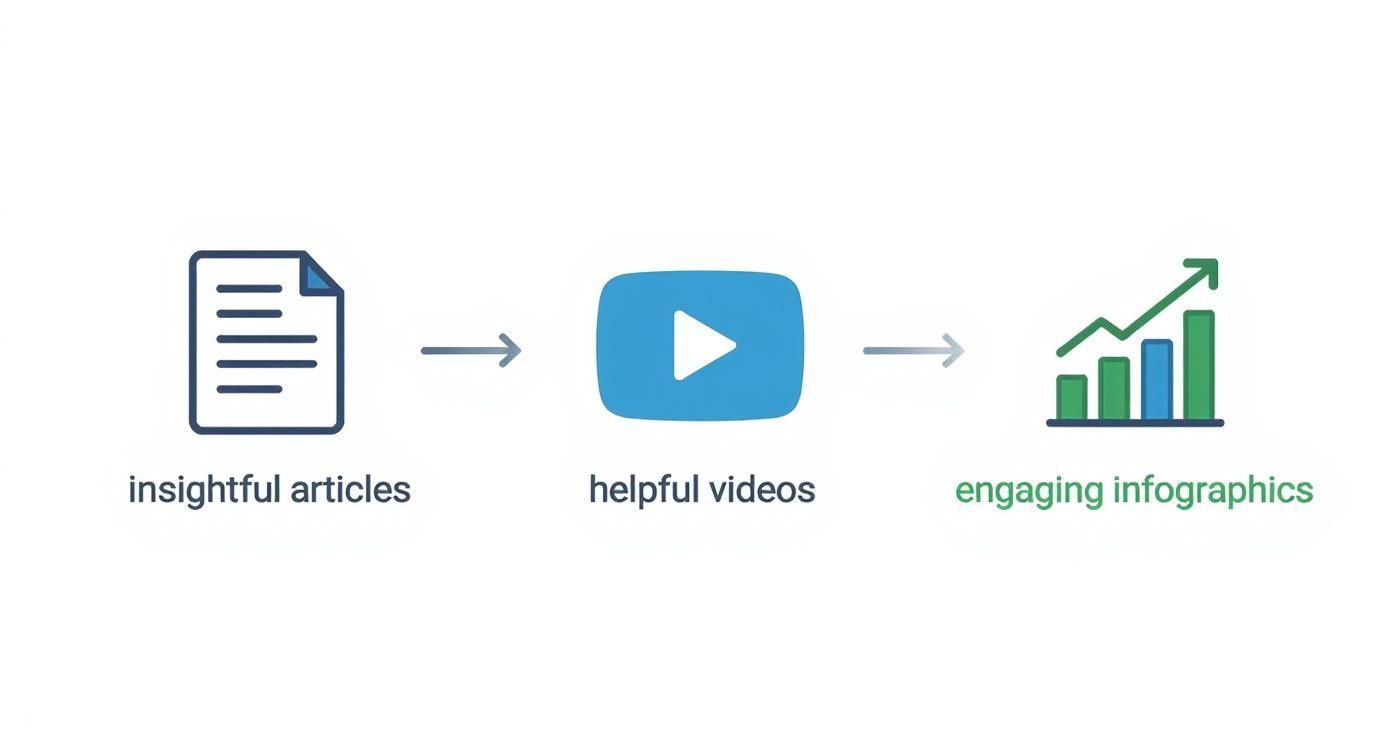
As you can see, a solid mix of insightful articles, helpful videos, and engaging visuals is what sets you up as an authority in your space.
Video, in particular, has a huge impact. To really connect with your audience and build that strong online community, it's worth looking into specialised social media video tools. Ultimately, mastering social media is all about consistent, authentic interaction that makes your brand a welcome part of your audience’s daily scroll.
Forging Strategic Partnerships and Collaborations
Trying to grow your brand awareness all on your own is a slow, painful grind. A much smarter way to play the game is to build strategic partnerships that get your brand in front of new, highly relevant audiences in a way that feels completely natural.
This isn’t about just finding any random business to team up with. It's about spotting collaborators whose audience is a perfect match for yours, but who aren't your direct competitors. Think of it as borrowing trust. When a brand your ideal customer already knows and respects gives you a nod, that credibility instantly rubs off on you.
Finding and Approaching the Right Partners
First things first, look for complementary businesses. A local wedding photographer could partner up with a florist, a venue, and a cake designer. It just makes sense. Together, they can offer package deals or cross-promote each other’s services, creating a win-win for everyone involved—especially the customer.
When you're ready to reach out, your approach has to be personal and focused on the value you can bring. A generic, copy and paste email is a one-way ticket to the bin.
Instead, try this:
- Do your homework: Show them you actually understand their brand and have a genuine reason for why a collaboration makes sense.
- Pitch a clear idea: Don’t be vague. Suggest something specific, like a co-hosted webinar or a joint guide for your shared audience.
- Show them what's in it for them: Clearly explain how they benefit, whether it’s getting access to your audience or co-creating some killer content.
The best partnerships are built on shared values and mutual respect. It’s not just a transaction; it's about creating something together that neither of you could have pulled off alone.
This simple shift turns a cold outreach into a warm invitation for a relationship that actually benefits both sides.
Making Influencer Marketing Work
Influencer marketing has become a serious powerhouse for brands here in the UK. When you get it right, it’s so much more than just a bit of product placement; it becomes authentic storytelling that genuinely connects with people. The real secret is finding influencers whose personal brand and values genuinely line up with your own.
In the UK, influencer marketing isn't just a trend; it's a massive strategy, with spending expected to hit £1.04 billion in 2025. Authenticity is everything, as 40% of UK social media users are influenced by endorsements from micro-influencers, especially in niche markets. With 33.4 million Instagram users in the UK, the potential audience is enormous. You can find more of the latest numbers in these UK social media statistics on Sprout Social.
Managing these relationships well comes down to clear communication. You need to be upfront about expectations and what you need them to deliver. It's also vital to measure your return on investment—not just in sales, but in things like reach, engagement, and how many more people are searching for your brand by name. This is how you make sure every partnership is a smart move for your brand’s growth.
Don't Forget the Real World: Using Offline Methods for Tangible Connections
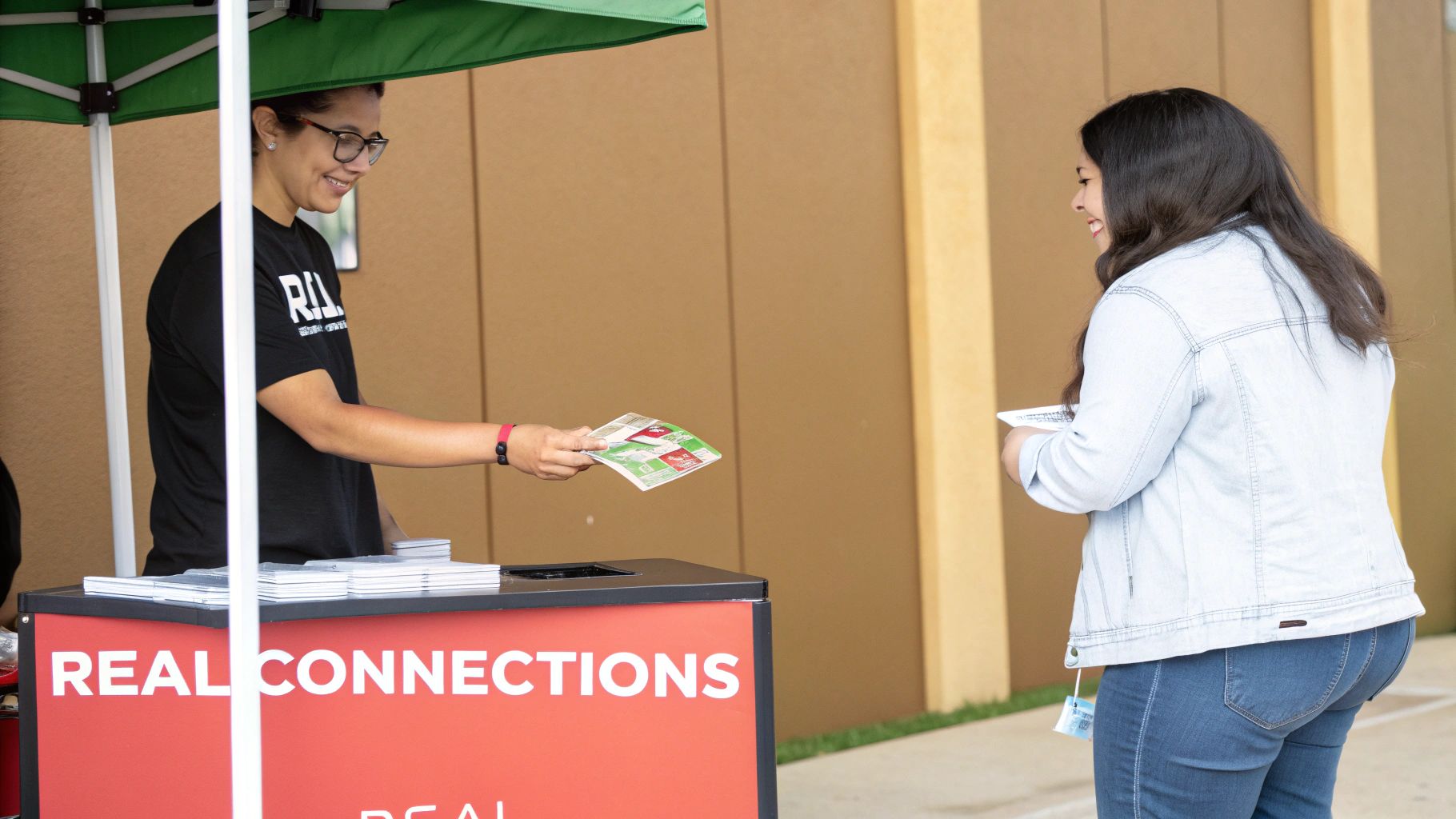
While your online presence is non-negotiable, the power of a real-world handshake is still unmatched. It’s easy to get lost in the digital noise, but effective offline tactics create memorable, lasting brand experiences that just hit differently.
Think of it this way: your offline strategy shouldn't compete with your digital one; it should complete it. This is how you stop being just another name on a screen and become something real and tangible that people feel connected to.
Stepping away from the keyboard allows you to meet your audience where they are, creating a level of authenticity that’s tough to manufacture online. Sponsoring a local charity fun run or setting up a stand at a community festival puts your brand right in the heart of what matters to people. It shows you’re part of their world.
Get Stuck In with Your Community and Industry
Showing up at events is one of the most direct ways to get your name out there, both in your local area and within your industry. It’s about being seen where it counts and making connections that go way beyond a simple follow or a like.
Here are a few ways to make this work for your brand:
- Sponsor Local Events: Putting your name on the shirts of a local kids' football team or sponsoring a stage at a music festival shows you’re genuinely invested in the community. This builds incredible goodwill and links your brand with positive, local memories.
- Attend Industry Conferences: Never underestimate the value of networking at trade shows and conferences. It’s your chance to meet potential clients face-to-face, spark up partnerships, and prove you’re an active player in your industry’s conversation.
- Host Your Own Workshops: Got knowledge to share? Host a free workshop or a small seminar. It positions you as an expert, provides genuine value to attendees, and creates a powerful personal connection.
An in-person interaction is a sensory experience that digital marketing just can't replicate. The handshake, the direct eye contact, the shared environment—it all builds a level of trust and memorability that sticks around long after the event is over.
These real-world touchpoints prove your brand is more than just a business; it’s part of the fabric of the community.
The Lasting Power of PR and Print
It might feel a bit old school, but don't write off traditional public relations (PR) and a bit of targeted print. Getting media coverage in a respected publication is a powerful stamp of approval that you can’t buy directly. It’s all about building relationships with journalists and giving them a great story, not just another press release.
A well-placed article in a trade magazine or a feature in the local paper can reach a dedicated, and often less digitally-swamped, audience. This kind of earned media gives your brand a credibility boost that paid ads often struggle to match. Think of it as a trusted third party giving you the nod.
Likewise, a cleverly designed advert in a niche publication can grab the attention of a very specific audience. The trick is to be strategic. Choose outlets that your ideal customer actually reads and trusts. When you mix these offline methods with your digital strategy, you create a powerful, multichannel approach that really resonates.
A Few Common Questions Answered
Even with a solid plan, you're bound to have questions. It’s completely normal to wonder about timelines, budgets, and how you even begin to track something as seemingly intangible as "awareness". Let's tackle some of the most common queries head-on.
Getting these details ironed out will give you the clarity and confidence to push forward.
How Long Does It Take to See Results?
There’s no one-size-fits-all answer here. The timeline really depends on your strategy, your industry, and how much you’re willing to invest. Organic approaches like SEO and content marketing are a long game—you’re planting seeds that might not fully bloom for 6-12 months .
On the other hand, a smartly targeted paid social media campaign or a well-timed influencer collaboration can give you a jolt of visibility almost overnight. The trick is to keep an eye on leading indicators from day one. Watch your website traffic and social engagement, but understand that a real, fundamental shift in brand recognition takes time to build.
What’s the Most Cost-Effective Way to Increase Brand Awareness?
If you're working with a tight budget, organic methods are your best friend. Creating genuinely helpful blog content that solves your audience's problems costs you nothing but time and your own expertise. It's a massive opportunity.
Likewise, picking one or two social media platforms where your audience actually hangs out and being consistently active is a powerful, low-cost move.
But the most overlooked tool for brand awareness? Exceptional customer service. Happy customers become your most vocal advocates, creating the kind of authentic word-of-mouth buzz that money simply can't buy.
Here are a few other highly effective and affordable tactics:
- Local SEO: Optimising your Google Business Profile is completely free and absolutely essential for pulling in a local customer base.
- Community Engagement: Getting involved in local events or relevant online forums helps you build real, authentic connections.
- Cross-Promotions: Teaming up with other local, non-competing businesses is a brilliant way to get in front of a new, relevant audience without a hefty price tag.
How Can I Measure My Brand Awareness Efforts?
Measuring brand awareness isn’t as straightforward as tracking sales, but it's just as important. You need to look at a collection of metrics that, when viewed together, paint a clear picture of your growing presence.
Key numbers to keep an eye on include:
- Direct Traffic: This is the gold standard. It tracks people who type your website URL directly into their browser—a sure sign they know you by name.
- Branded Search Volume: This tells you how many people are searching specifically for your brand name in Google. Seeing this number climb over time is a huge win.
- Social Media Mentions: Monitor both tagged and untagged mentions of your brand across all your platforms. This is the digital version of word of mouth.
Tracking these figures consistently will show you whether your hard work is actually moving the needle and getting your brand the recognition it deserves.
Ready to stop being the best-kept secret in your industry? The expert team at Superhub specialises in creating bespoke marketing strategies that get your brand seen and remembered. We combine data-driven insights with creative flair to build a presence that lasts. Find out how we can help your business grow.

